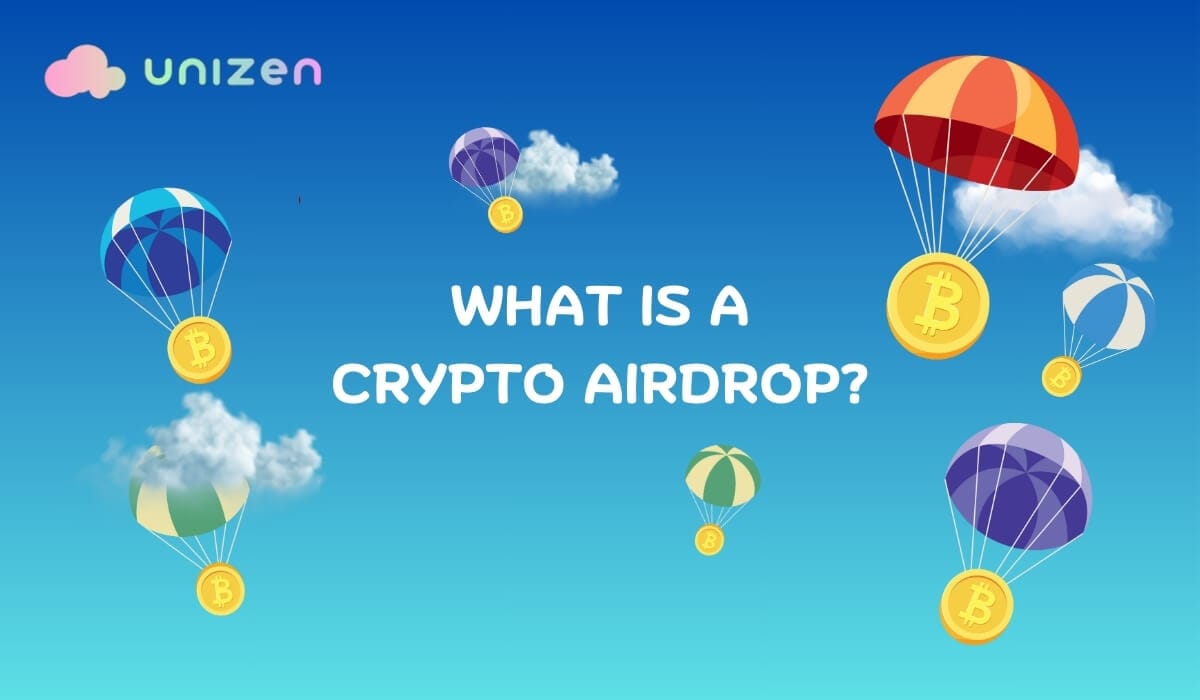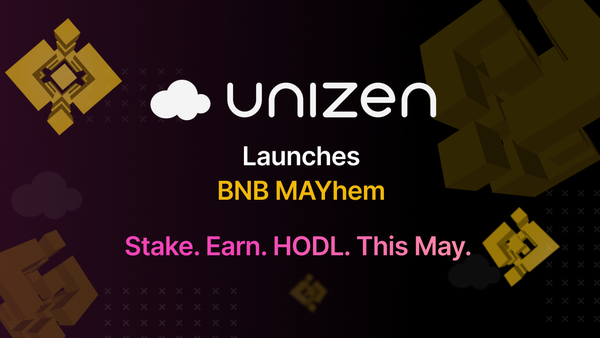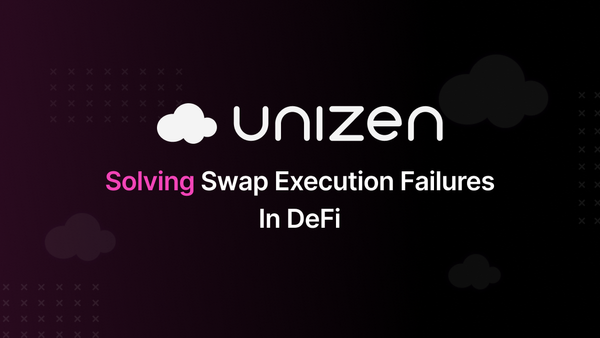What Is a Crypto Airdrop?
Wondering what is a crypto airdrop? Discover what cryptocurrency airdrop means and how blockchain projects distribute tokens to valid wallet addresses.

Amongst the recent upsurge in cryptocurrency, one of the most asked questions is: what is a crypto airdrop? It is a marketing and distribution strategy of free cryptocurrency tokens to certain end-users on account of blockchain-based projects. The whole endeavor has been to benefit the projects by promoting themselves and creating awareness while rewarding the users for trying out the tokens, not directly paying for them. Crypto Airdrop is a marketing stunt for new blockchain projects looking to establish a user base or reward early adopters of their platforms with several tokens. The tokens are distributed among the owners' wallets and then can take value with the project's development. It is a pretty cool deal for both parties. Platforms like Unizen, a next-generation smart exchange ecosystem, exemplify how airdrops can engage communities and promote new blockchain innovations.
How Crypto Airdrops Work
Crypto airdrops are the direct distribution of tokens and coins to addresses of wallets, and these addresses must meet certain standards. The processes of this distribution may also differ, depending on the project and its aims and objectives.
Basic Mechanics of Distributing Tokens
The regular process of distributing tokens through an airdrop includes several steps. These are considered quite crucial for successful and transparent distribution.
Eligibility Criteria
They are set by the project team. These requirements normally stipulate exactly who will be qualified to take the airdrop and usually target select segments of users. This may include holding a particular cryptocurrency in a wallet and interacting with the platform on which the project has been built. It can also include executing specified activities such as staking or social media interaction to receive free tokens. It mainly goes to reward loyal community members or induce desirable behavior that eventually will contribute to the growth and ecosystem of the project.
Snapshot
Once the eligibility requirements are defined, the project takes a snapshot of eligible wallets. This snapshot records all addresses that meet the predefined criteria at a specific point in time, often marked by a particular block height on the blockchain or a set date. The snapshot is essential because it is the reference point for identifying who will receive the tokens. Users who meet the criteria after taking the snapshot are generally not included in that particular airdrop.
Token Distribution
Immediately following the snapshot, token distribution will be initiated. Platforms like Unizen automate this process using smart contracts, ensuring transparency, accuracy, and fraud prevention during token allocation. Practically everything is automated through a smart contract deployed on-chain. This will ensure that credits are given to the various eligible wallets in such a manner that prevents interference. It prevents any error or fraud. The distribution can be immediate or scheduled within a given time frame. This depends on the strategy of the project itself and its stipulated tokenomics.
Wallet Verification
Extra Steps: this may involve other pre-distribution verification steps of the crypto wallet by some projects to ensure users can receive the airdrop. This may include the pre-listing of wallet addresses on the project's website or even on its platform. In some cases, especially those in which some form of regulatory compliance should be observed, users are asked to verify themselves via Know Your Customer. It can also ask the users to link their wallets with social media accounts or any other form of verification in place that may block scams and ensure tokens truly go to members of the community.
Criteria for Receiving an Airdrop
There are various criteria users must meet to qualify for an airdrop. Common eligibility requirements include:
Holding a Specific Cryptocurrency
The most usual qualifiers are based on maintaining a certain type of digital currency. For instance, they should have a particular token or currency in the wallet, such as Ethereum, Binance coin, or the project’s token. The amount to be held might differ, and, at times, the holding period. For instance, a holding period may be required. This strategy rewards existing holders and encourages stable or higher demand for the cryptocurrency.
Participating in a Community
The other common criterion is participation in the project's crypto community. In general, active activity within a project’s ecosystem can be enough to get a user an airdrop. This can mean leaving comments on discussion boards, offering feedback, voting on important decisions, or anything you do while engaging with the community. They regard it as something deserved by those who invest their time into the project’s development and are eager to build an active community.
Completing Tasks
Some projects require users to perform pre-specified tasks to be awarded in the airdrop. As a rule, such tasks are formulated to enhance the project's popularity and audience. Such actions can include following the project’s accounts on social networks, reposting or sharing the promotion materials, inviting new people to join the project, or registering in the project's Telegram or Discord channels. The accomplishment of these tasks is, as a rule, confirmed with the help of automated software or by conducting a visual inspection.
Using the Platform
Eligibility can be made dependent on the usage of the project's platform or dApp. This is one of the ways to make sure that only users who are posting relevant content often receive the airdrop with an incentive. Some examples may be trading an asset on a DEX, staking some tokens, creating an NFT, or adding liquidity to a pool. In return, the project will drive more on-chain activity and prompt users to discover its offerings.

Types of Crypto Airdrops
There are various crypto airdrop types. Understanding these types can help users identify opportunities and participate effectively.
1. Standard Airdrops
Standard crypto airdrops are those forms of cryptocurrency distribution whereby tokens are automatically sent to all holders of a particular cryptocurrency. These are usually employed to reward loyal users or spread awareness about the cryptocurrency project by leveraging the user base of some other blockchain or token. The balance might, for example, be distributed to all the holders of a particular cryptocurrency when a certain project launches on the Ethereum network to get immediate exposure and adoption. To qualify, users must often hold a minimum balance of the designated cryptocurrency in a compatible wallet at a specific snapshot time. This type of airdrop is very straightforward and aims to create awareness while fostering user engagement.
2. Bounty Airdrops
Bounty airdrops are those where one has to perform certain tasks or actions to get the tokens. These include promoting the project on social media, for example, sharing posts, following official accounts, or creating content like blogs and videos. Other examples include joining the project community channels, referring new users, or completing surveys. Bounty airdrops are a marketing strategy for the project to be recognized and attract more people. Bounty airdrops encourage engagement or performance instead of mere possession and thus make it a powerful form of direct outreach and community incentive.
3. Exclusive Airdrops
Exclusive airdrops are targeted distributions aimed at active users or communities, usually basing their criteria on some historical activity with the project. This includes holding particular NFTs, being part of a community, or even a partner community. These airdrops also reward early supporters, testers, or loyal users who have somehow contributed to the success of this or that project. Because they are selective, exclusive airdrops usually have higher perceived value in the distributed tokens and the recognition they give to recipients. This kind of airdrop also creates a community loyalty culture, promoting long and strong stakeholder relationships.
Benefits of Crypto Airdrops
Crypto airdrops offer numerous advantages for both projects and participants.
1. Marketing and Promotional Tools for New Projects
The promotion of newer blockchain projects is hard to come by. However, crypto airdrops are one of the best methods of marketing. Products give out free tokens that create awareness and garner attention from prospective investors, developers, and users. This normally leads to hype creation in the crypto communities and beyond, including media and social media hype. Moreover, it allows new projects to demonstrate their technology and the utility of their token practically, encouraging users to try their platform. It can also make a project stand out from the competition and give it initial adoption, positioning it for long-term growth.
2. Incentivizing Community Engagement and Loyalty
Airdrops are important tools for encouraging user participation and creating a fan base. This keeps users engaged in the crypto space at the early age of the project or when very engaged in the project’s activities. Examples may involve engaging and providing feedback or working towards the project's marketing on social media platforms. In the long run, such incentives cultivate a fan base whose primary interest is the project's progress. Loyal users not only enhance the project’s authenticity but also bring new users through recommendations and constant engagement with the platform.
3. Increasing Token Distribution and Decentralization
Another goal of airdrops is to increase token distribution for better decentralization. Unizen ensures wide token distribution across its user base, enhancing decentralization and fostering a more resilient blockchain ecosystem. The wide distribution of airdrop tokens among a big circle of users prevents the concentration of wealth and power in big holders' hands, also known as whales. Such decentralization corresponds to the very essence of blockchain and gives more democracy and resilience to the network. The supply of tokens is also a factor; a well-distributed token supply is more liquid and appeals to exchanges and investors. Besides, it helps to avoid the possibility of authorities inflating the value of digital currency and maintain a healthy and stable token environment for the project’s future development.

Challenges and Risks
Despite the advantages, however, some risks follow crypto airdrops that must be known:
1. Potential for Scams and Fraudulent Airdrops
One of the major risks developed with cryptocurrency airdrops involves scamming and fraudulent actions. Many crypto scams appear to make innocent users disclose private keys, wallet addresses, or sensitive identification details, pretending to be legitimate projects. Fraudulent drops might include phishing links or infected files to breach the user's wallet and access its contents. Other projects only perform airdrops to inflate their token's popularity and market perception without ever intending to deliver value to the recipient, thus undermining the concept of a holder airdrop. To avoid this situation, users must conduct thorough research on any project, verify its legitimacy, and not share sensitive information when participating in an airdrop.
2. Regulatory Challenges and Issues of Compliance
Airdrops often encounter much regulatory attention, and as such, they might be regarded as unregulated securities sales or money laundering tools. Major jurisdictions like the United States use the Securities and Exchange Commission to closely monitor these distributions to determine if they comply with securities laws regarding new tokens. Projects that do not stick to the regulatory frameworks are in danger of facing penalties, fines, or legal action, which would affect their operation and reputation. In addition, there are possible tax liabilities for users who receive airdropped tokens, as most countries regard such tokens as taxable income. Projects need to comply with local regulations and be proactive in seeking the advice of legal experts to avoid such challenges.
3. Dilution of Token Value by Undue Distribution
Excessive airdrop rewards can be very damaging for the token since they reduce the value of the tokens and, thus, the overall token utility and survivability of the project. If more tokens are created without a converging demand, the supply of the tokens in the market goes up, thus leading to a decline in the prices of the tokens. This devaluation not only impacts the token holders but also erodes investors' confidence and decreases their relative value in the market. To avoid such dilution, projects should carefully design their airdrop strategy to balance the distribution. This should align with the tokenomics model and incentivize meaningful community engagement rather than short-term speculation.
Notable Examples of Crypto Airdrops
Several notable crypto airdrops have made a significant impact on the cryptocurrency industry. Here are some prominent examples:
Uniswap (UNI) Airdrop
Uniswap did facilitate the airdrop of 400 UNI tokens to each address present and trading on Uniswap. This was done before it was snapshot in September 2020. This has been a very important facet in keeping Uniswap relevant and secure in its dominance over the DEX market. Allowing users to be involved in deciding on the protocol has further incentivized their use, hence boosting liquidity and volume. There was a monumental increase due to the success of the airdrop.
Apecoin (APE) Airdrop
In 2022, direct Airdrops of Apecoin were made to holders of Bored Ape Yacht Club and Mutant Ape Yacht Club NFTs, who got 10,000 APE tokens in supply. The active NFT community received an airdrop that stimulated high buzz and utility within the BAYC ecosystem. Place Apecoin well in position as a governance token for the decentralized community. This strategic airdrop enhances the utilization of Apecoin. It further helps the growth of leading brands for BAYC in the broader Web3 and NFT ecosystem.
Stellar (XLM) Airdrop
Stellar launched a $125 million airdrop of XLM coins to its users. This provided crypto users with a reason to carry out cross border payments through the use of Stellar’s blockchain. This was done in partnership with Blockchain in 2017. It assists in increasing the number of ordinary users of Stellar, and using it as an asset helps raise awareness of its use in airdrops. Though the airdrop helped generate early momentum, Stellar struggled to maintain long-term growth as more competitors entered the space. Nevertheless, the airdrop is still one of the most influential cases of large-scale distributions for network adoption.
dYdX (DYDX) Airdrop
The 2021 airdrop of dYdX was intended to reward active users on this decentralized derivatives exchange with a certain amount of tokens. In essence, it will encourage more use and, therefore, contribute to increasing the user count. DYDX is a governance token and forms part of the mechanism for rewards that add to increased liquidity and engagements within the protocol. It has been an important airdrop that finally sealed the leading position of dYdX within the Decentralized Finance derivatives market, sending even more growth into the platform.
How to Participate in Airdrops Safely
Be security-conscious when engaging with airdrops, especially involving personal data and funds. For example, on the Unizen platform, security is guaranteed, and the airdrop events are wholly legitimate and transparent, with minimal chance of fraud or scams.
Steps to Identify Legitimate Airdrops
First, check whether this project is actual. Again, research such things as the team, goals, and community activity of the project using the project's official site, whitepaper, social media, and blockchain explorer. Most serious projects have transparent info, regular updates, and a roadmap. Be suspicious when an airdrop asks for sensitive data private keys or promises unrealistically high returns. Airdrops from popular platforms or with the participation of famous partners are fairly reliable. Check cryptocurrency news sites or other platforms like CoinGecko, CoinMarketCap, or forums like Reddit to see the project's reputation.
Security Tips to Safeguard Personal Information and Assets
When participating in airdrops, prioritize protecting your personal information and assets. Never share your private keys or seed phrases with anyone, as legitimate airdrops should never ask for these. Use a dedicated wallet with a strong, unique password for airdrops to minimize risk. Enable two-factor authentication (2FA) on all your accounts to add an extra layer of protection. Please beware of phishing; check URLs carefully to ensure it is the official website. Never use your main wallet for airdrops. Consider using a hardware wallet if the amounts are large enough to be worth the security. Finally, stay up to date with scams and be cautious of red flags, such as an airdrop that requires payment upfront or one that charges people fees.
Tools and Platforms for Tracking Upcoming Airdrops
A variety of tools and platforms will help you in keeping tabs on legitimate airdrops. Crypto news Websites like AirdropAlert, Airdrops.io, and the airdrop section at CoinMarketCap list the current and future airdrops. Often, such platforms provide in-depth information about participation and requirements. Furthermore, many Telegram channels and Twitter accounts have been created focusing on airdrops; following these will keep you updated about new opportunities and potential raffle airdrops. Some even compile all the information about airdrops, such as deadlines, rewards, and eligibility requirements, in one place to filter the available offers easily. Be careful and take only updates from highly trusted platforms about upcoming airdrops.
Future Trends in Crypto Airdrops
As the cryptocurrency industry evolves, airdrop strategies will likely become more sophisticated.
Emerging Strategies and Innovations in Airdrop Campaigns
With the growth of the cryptocurrency space, strategies and innovations behind airdrop campaigns keep evolving as well. Unizen is leading this evolution by including cross-chain airdrops and gamification to attract user interest and drive platform adoption on more blockchain networks. Indeed, one of the important trends right now is deeper integration with DeFi protocols. Nowadays, projects are more often rewarding participants with governance tokens or staking rewards instead of the usual airdrop. This incentivizes long-term involvement in the ecosystem rather than just a single reward.
Other strategies now coming to the fore include NFT airdrops, in which projects provide special access to unique content or platform privileges. Airdrop campaigns will also be more focused and data-driven, leveraging on-chain analytics to identify and reward those displaying certain behaviors as active users of particular ecosystems or holders of specific tokens. More recently, gamification has been a growing trend, where projects create game-like experiences that users must interact with to be qualified for airdrops. This approach is used to provide much better engagement with the community and more visibility for the project.
Predictions for the Role of Airdrops in Future Crypto Projects
In the future, airdrops in crypto projects will likely evolve quite dramatically. Airdrop campaigns will continue being essential to blockchain ecosystems for many years to come, not just in the marketing of projects but in building decentralized communities. Projects in the future will possibly focus on airdrops as a way to onboard users but with increased utility and long-term commitment. With increased regulatory scrutiny, airdrop structures could shift to comply with legal requirements, making them more transparent and ensuring that recipients meet certain eligibility criteria. Airdrops will further decentralize their distribution mechanisms, whereby smart contracts guarantee more equable and transparent processes.
Additionally, airdrops will be integrated into other crypto use cases, including early access to governance rights, staking rewards, and participation in DAO-driven projects. If the use of different blockchains continues to increase, there may very well be crossover airdrops within the multiple networks for participants to gain tokens, thereby promoting greater usage of the various protocols.
Conclusion
Crypto airdrops have emerged as the most potent methods that many cryptocurrency projects can use to raise their profiles, reach out to communities, and incentivize users. Airdrops are used to increase the project’s audience since tokens are distributed to their holders or others who participate in the event. The same has happened with the various aspects surrounding these cryptocurrencies, where different strategies are adopted for these campaigns.
With each new trend appearing, including DeFi, NFTs, and gamification, for example, airdrop initiatives become very creative and specific. In the future, airdrops will probably play an even more prominent role in the success of crypto projects with increased utility, more transparency, and long-term engagement in mind. What is a crypto airdrop, then? It's not just free tokens anymore. It's about building lasting value in decentralized ecosystems, driving growth and adoption across multiple blockchain platforms.



